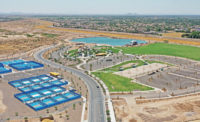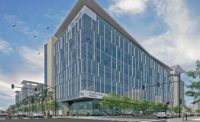Construction is a tough business, and staying around for a long time takes a certain set of skills. In the case of 111-year-old Clark Group, this not only means a lot of old-fashioned hard work, but also maintaining open communication with subcontractors and stakeholders, building trust with a steady stream of repeat clients and diversifying into many different sectors.
“What drives Clark is our diversity of capability,” says Steve Dell’Orto, Clark senior vice president in San Francisco. “We are deep in our expertise but also broad in our product type that we build. We build anything from high-rise office buildings and sports venues to student housing and academic buildings to large-scale health care projects, aviation and more.”
This diverse expertise is on full display in California, where the company currently has about $4.9 billion in active construction underway in 29 projects across the state.
Early Partners
One of the company’s biggest and most anticipated projects is the new $1-billion Chase Center in San Francisco’s Mission Bay. Built in a construction manager at-risk joint venture with Mortenson Construction, the project is scheduled to be finished in time for the start of the NBA champion Golden State Warriors’ 2019 season.
The 18,000-seat venue will anchor an 11-acre district of restaurants, offices and public plazas along a new 5.5-acre public waterfront. Crews are presently completing mass excavation, working on deep foundations and erecting five tower cranes in preparation for going vertical with concrete in August.
Jim McLamb, senior vice president of operations for Clark’s Western region, says his company has taken several measures to ensure the delivery of a state-of-the-art facility.
“From the start, we knew that assembling a world-class team for this project was critical,” says McLamb, who is also project director for Chase Center construction. “Working in a design-assist capacity, we have been able to involve a number of critical subcontractors very early in the construction process to help with constructibility and logistics.”
This early team partnering paid off when the project faced a construction challenges in the form of Bay mud on the jobsite. McLamb says the team spent more than a year working with its geotechnical and structural engineer to design a foundations system that would work in less than ideal soil conditions but that “would still allow us to maintain an aggressive schedule.”
Providing Certainty
In Southern California, where Clark has 18 active construction projects worth about $3 billion, Carlos Gonzalez, senior vice president for the region, says the new $400-million Long Beach Civic Center that Clark is building is something to watch. “This is a project that will be transformative for the city of Long Beach and the port,” says Gonzalez.
Being developed under a public-private partnership (P3), the complex is highlighted by a 274,000-sq-ft city hall, a 237,000-sq-ft port headquarters, a 92,000-sq-ft main library and below-grade parking facilities. It is scheduled for completion in mid-2019.
“From a delivery standpoint, this is a project where Clark brought its development and long-term operation and maintenance expertise,” says Gonzalez. “P3s are a delivery method that distinguishes us among our peer group, and they are a very good avenue to provide infrastructure.”
A successful P3 requires a “certainty of cost and schedule” at the project’s beginning, while the design is still in its early stages, he says. “And that’s what makes us so good—our experience and the quality of our development executives allows us to establish a reliable budget and schedule and provide good information to the end users so they can make good decisions,” says Gonzalez.
“In the heat of the battle, when we sit across the table from Clark and we get to a point where the number is going too low ... [Clark] doesn’t try to strong-arm us.”
– Carrie Byles, Partner, SOM
Carrie Byles, a partner with Skidmore, Owings & Merrill LLP (SOM), likes working with Clark because of its ability to keep projects on budget and schedule, especially when vying for jobs against other project teams.
“These pursuits get very competitive, and you want to be careful that nobody gets into such a frenzy that a [contract dollar number] is put out there that would not be achievable,” says Byles, whose firm is working with Clark on the Long Beach Civic Center.
“In the heat of the battle, when we sit across the table from Clark and we get to a point where the number is going too low and it’s not going to be appropriate for the client and we can’t stand by it, [Clark] doesn’t try to strong-arm us,” she says. “We look at each other, nod our heads and say if somebody can do it for lower than this then more power to them. And this shows a level of integrity and being aligned and only putting things forward that are achievable and appropriate.”
Byles says that because SOM has done so many buildings with Clark, the two firms have a high level of trust between them. On some of their design-build pursuits—especially those with stipulated sums—they are able to give the client “a more innovative solution because Clark knows us and trusts that we will work through it with them and find a way to deliver it for that price,” she adds.
One such case is the $400-million, design-build U.S. Federal Courthouse building in Los Angeles, which was completed last year. During the design competition to win this project, Byles says SOM came up with a plan to suspend the exterior wall from the roof.
“Not many contractors would want to do this, period, let alone put a guaranteed maximum price to it,” she says. “When you are going into a design-build competition and everything is being done at a rapid pace; and you are only taking the project to a partial schematic design level; and you’re asking the contractor to give a guaranteed maximum price; and they are allowing the design team to do something that has never been done before? Now that is trust.”
Ken Long, president of Largo Concrete, pointed to Clark’s preplanning and communication skills as things that stand out to him.
“They take an active role in coordinating subcontractors,” says Long, whose company is also working on the Long Beach Civic Center. “Some general contractors take the approach that everybody is expected to coordinate among themselves, and that is not always efficient and realistic. But when somebody acts as a leader and gets involved with studying everyone’s roles on a job and what they are trying to accomplish, it’s much more effective and that’s what happens when we work with Clark.”
Retaining Customers
Dell’Orto says 80% of the company’s projects involve repeat clients or partners. For example, Clark currently has crews working on three separate jobs for the city of San Francisco. “These three projects are all critical facilities and very important to the city,” says Edgar Lopez, deputy director for buildings and city architect for San Francisco Public Works. “[Clark is] very good at their preconstruction services. They help us vet the projects and validate the budgets. They ask a lot of good questions and solve problems early rather than later during construction.”
The largest of these three projects is the new $65-million Office of Chief Medical Examiner, which is headed for a September completion. Clark is working with San Francisco-based KMD Architects on this 46,000-sq-ft facility.
“We hired them after we had a design consultant onboard and they looked through the budget from top to bottom and brought up issues we hadn’t considered, and as a result we were able to validate that we had the right budget and scope,” says Lopez.
As Clark wraps up its current slate of projects, Dell’Orto says, the company is continuing with its strategic plan, focusing on its partnerships and creating a great place to work. “We’ve been blessed to have a very robust backlog, and we feel very good with where we are for the next two to three years,” he says.









